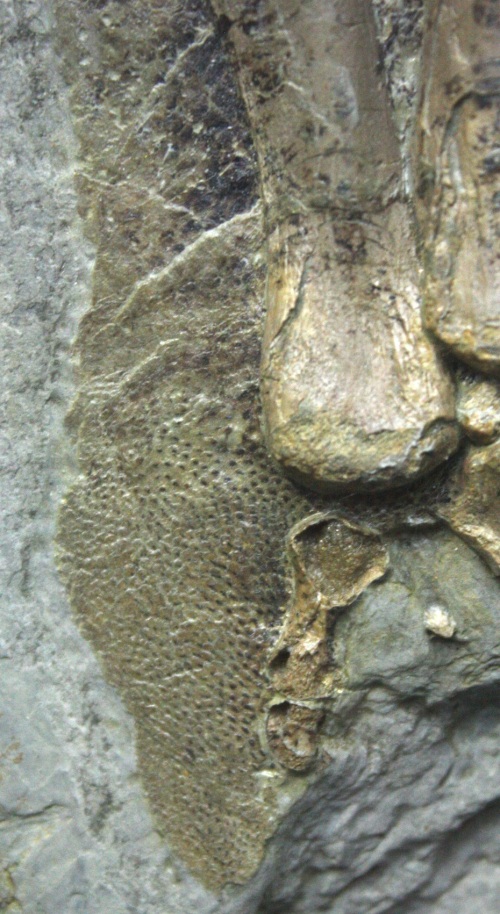By now most people with even a passing interest will be aware of the fact that there are now a number of specimens (and indeed species) of ornithischian dinosaurs that are preserved with some form of filament-type structure which, superficially at least, bear some resemblance to primitive feathers. However when the first candidate was announced, this specimen of Psittacosaurus housed in Frankfurt, it inevitably causes something of a furore with many suspicious of the data and suggestions that the filaments were simply coincidentally preserved plant stems or something similar.
The discovery of multiple specimens of Tianyulong inevitably make this rather more plausible as a real find, though of course a few more filamented Psittacosaurus would be nice. A third taxon is apparently now know but sadly illness led to a no-show at SVP so few have seen anything of this new find. Still, the original find is an impressive specimen, but doesn’t seem to have really been thoroughly described or illustrated too well and as I’m in a position to at least partially rectify that, here’s some photos I took of the specimen on my recent trip.
I have actually seen this before years ago but extremely briefly, and have also seen a superb cast of it in the Carnegie (my photo of which actually popped up in a dinosaur text book recently, [with permission I should add] such was the quality of the copy). However, I’d never really *looked* at it properly and actually spending a few minutes (even through a glass case) reveals some lovely details.
First off, it’s big. The biggest specimen I’ve seen by far for this genus, though the head is not that large compared to the rest of the body. Then there is skin pretty much everywhere – this does turn up in Liaoning not too infrequently, but rarely to this extent or quality. It covers large chunks of the animal and even completely covers large chunks of the bones in places (just look at the femur) and it looks like there’s a pile of gastroliths in the gut that are also covered.
While I’d be very cautious about interpreting the extent of the skin as being directly linked to other soft tissues, the extensive ‘flap’ behind the hindlimb would correspond with what you might expect from large retractor muscles there and so might well be genuine. Not only that, but there’s quite a bit of texture to the skin and in a couple of places it appears to have a different surface texture to others (see the underside of the base of the tail, and the area around the toes), which could also be genuine. On top of that, both the individual scales are clear in some places, and are even coloured differently (the larger ones are black) implying at least the possibility of this representing a pattern on the animal, and this changes along the body (look a the concentration in the tail, compared to the legs) though again:caution. It does look rather like this little patch that I featured years ago which is rather neat. Finally, this pattern also extend onto bones that are not obviously covered with skin (see the distal forelimb for example) with apparently the stains or some other taphonomic artefact of the scales left on the bones themselves.
And yes, then there are the filaments. Sprouting up off the base of the tail and extending most of the way along its (incomplete) length. They are rather thick and clearly somewhat stiff, but also flexible enough to bend under their own weight. While not a common reference, they look a lot to me in terms of their apparent properties like the tail hairs of giraffe (though much, thicker). It’s a real shame they are at least in part cut off the edge of the slab, but certainly appear to have stopped appearing well short of the end of the tail, so their full extent does appear to have been preserved.
I think that’s everything I can reasonably (or even unreasonably) speculate about this specimen without, yknow, actually going back and reading the original paper and associated commentary. However, the really key thing is of course that here’s some nice pictures of this and it gives a welcome opportunity to revisit this important and interest specimen.










Recent Comments